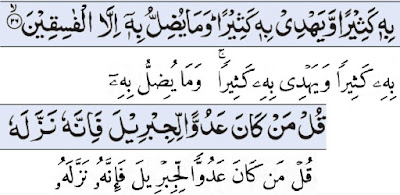Some "see" blue, black and white.
others see strokes and dots,
others Arab words, or words from the beginning of the qurʾān or (among other things) 18 "dagger alifs". I see only nine.
A "dagger alif" is a small alif, an Ersatzalif (supplementary alif)
or a Wandelalif (transforming alif).
The similar looking signs in the "Indian" muṣḥaf from Medina
are no alifs, but fatḥas, standing fatḥas or turned fatḥas,
not letters but vowel signs.
I fail to understand, how anybody can confuse a sign that sits on its letter (or near its ascender)
with a letter that follows a letter+vowelsign-combination.
Once one knows that in the African notation there must be a ḥarf al-madd to lengthen the vowel,
whereas in the Asian notation fatḥa, kasra, ḍamma each have a turned variant for the long vowel,
one SEEs the difference.
Whoever does confuse long vowel sign and Ersatz letter is blind.
In the last line: two Wandelalifs:
there is a ḥarf al-madd, but the wrong one: instead of alif (expected after fatḥa): waw resp. yāʾ here the small alif transforms waw resp. yāʾ into alif. (In the blue line above: (long) standing fatḥa again.)
So not 18 dagger alifs, just seven Ersatzalif plus two Wandelalif.
Not convinced?
Look at these examples.
If you don't see "arguments", study something else (you are not made to study the writing of maṣāḥif).
Here the text from the King Fuad Edition about the small letters (among them "dagger alif"):

And about fatḥa, standing fatḥa, kasra, standing kasra, ḍamma and turned ḍamma.






No comments:
Post a Comment